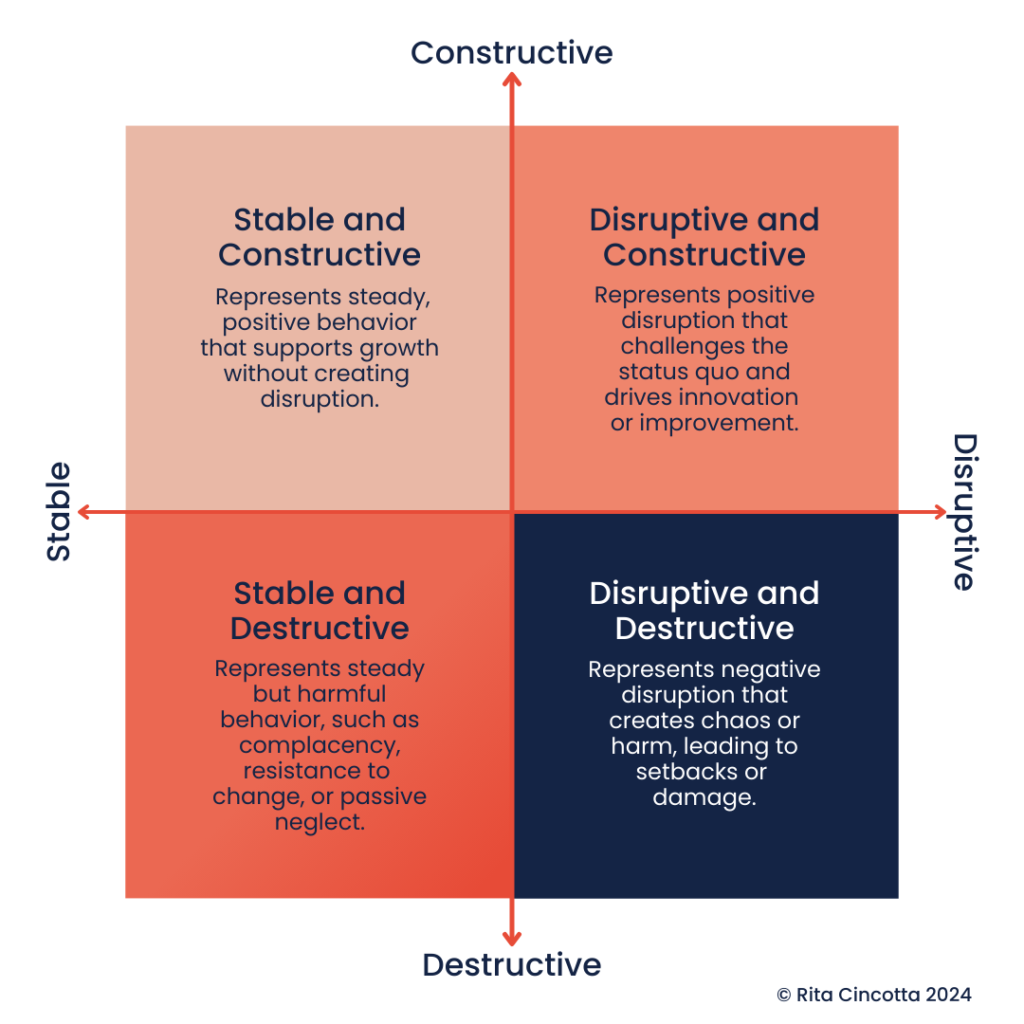As a deliberate leader, you will likely need to navigate different types of behaviours in your team. While disruption is often seen as a negative force, it can also be a driver of innovation and growth. By understanding how to categorise and manage disruptive behaviours versus stable ones can help you lead more effectively. This matrix offers a clear way to break this down, using two dimensions: Stability vs. Disruption and Constructive vs. Destructive.

Here’s how the matrix works:
🚀 Stable and Constructive
This quadrant represents steady, positive behaviour that supports growth without
challenging the status quo. Leaders and team members in this category work
consistently and reliably. Their actions contribute to maintaining and improving
current systems, which is essential for long-term success. However, while this
behaviour is safe, it can sometimes lead to stagnation if innovation is needed. A good
example is an employee who follows processes diligently and excels in their role but
doesn’t push boundaries or propose new ideas.
🚀 Disruptive and Constructive
Disruption doesn’t have to be negative. In fact, disruptive and constructive behaviour
is the key to driving innovation and improvement. These are the team members who
challenge the status quo and propose creative solutions. They might shake things up,
but their intentions and outcomes are beneficial to the organisation. As a deliberate
leader, it’s essential to recognise the value of these individuals and harness their
energy in a way that aligns with the organisation’s goals. These disruptors are often
the change-makers, essential for adapting to an evolving business environment.
🚀 Stable and Destructive
Not all stable behaviours are positive. This quadrant reflects steady but harmful
actions. Think of complacency, apathy, or resistance to change. These behaviours
may not cause immediate disruption, but over time, they erode progress, morale, or
performance. A team member in this quadrant might resist new initiatives, holding
back innovation and causing harm in the long run. Leaders must be vigilant in
identifying and addressing these behaviours before they become systemic.
🚀 Disruptive and Destructive
This quadrant captures the behaviours that leaders fear most—those that not only
disrupt the team or organisation but also cause harm. These individuals create chaos,
undermine team cohesion, and derail progress. Immediate intervention is required
here. It’s critical to address these behaviours head-on, as they can destabilise a team
quickly.
Applying the Matrix
By using this matrix, deliberate leaders can better understand the different types of
behaviour within their teams. Recognising when disruption is a force for good or when
stability is masking deeper issues allows for more intentional leadership decisions.
Deliberate Leaders balance innovation with stability, guiding their teams to leverage
disruption positively while addressing harmful behaviours before they cause lasting damage.
Upcoming Events
👉🏻I Don’t Have Time – How to Better Organize Yourself and Your Team
Event Details:
📆 Monday, October 21, 2024
🕛 12:00 – 1:00 pm AEST
📍 Zoom
REGISTER 👉🏻 HERE 👈🏻
Thanks for subscribing to my weekly insights. Here are some other ways we can work together:
💬 One-on-one coaching
🎯 Leadership development and training
🎤 Book me as a Speaker or MC for your next event

